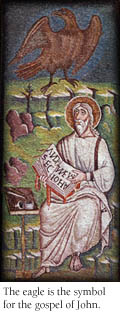The Gospel of John
The so-called "spiritual gospel" which presents Jesus as the "Stranger from Heaven," stands apart from the other three.by Marilyn Mellowes
 "In the beginning was the Word, and the Word was with God, and the Word was
God. He was in the beginning with God, and through him were all things made."
These words of the opening prologue of the fourth gospel provide a clue to the
nature of this work: it stands apart from the three synoptic gospels. It has
often been called the "spiritual gospel" because of the way that it portrays
Jesus.
"In the beginning was the Word, and the Word was with God, and the Word was
God. He was in the beginning with God, and through him were all things made."
These words of the opening prologue of the fourth gospel provide a clue to the
nature of this work: it stands apart from the three synoptic gospels. It has
often been called the "spiritual gospel" because of the way that it portrays
Jesus.
If Matthew's Jesus resembles Moses and Luke's Jesus resembles a Greek philosopher or a semi-divine hero, John's Jesus resembles the Jewish ideal of heavenly Wisdom. Some Jewish works written several hundred years before John's gospel portrayed Wisdom as God's heavenly consort. This Wisdom, pictured as a beautiful woman, lived with God and participated in creation. Another part of the myth regarding her was that she descended to earth to impart divine knowledge to human beings. But she was rejected and so returned to God.
Another interesting feature of John's gospel is that Jesus speaks in long monologues, rather than pithy statements or parables. He openly proclaims his divinity and insists that the only way to the Father is through him. Motifs of light and darkness are woven throughout the gospel: these are not simply literary motifs, but devices that give clues about the community for which John was written.
It was a community under stress. The gospel itself suggests that its members were in conflict with the followers of John the Baptist and were undergoing a painful separation from Judaism. The group itself was probably undergoing desertion and internal conflict.
Tradition has credited John, the son of Zebedee and an apostle of Jesus, with the authorship of the fourth gospel. Most scholars dispute this notion; some speculate that the work was actually produced by a group of early Christians somewhat isolated from other early Christian communities. Tradition also places its composition in or near Ephesus, although lower Syria or Lebanon are more likely locations. The most likely time for the completion of this gospel is between 90 and 110 CE.
The central theme of this work is ascent/descent. Jesus is presented as one who travels freely between the dual realms of heaven and earth. As Wayne Meeks has written, he is "the Stranger from Heaven." He -- and he alone -- knows the Father; belief in him is the only way to reach the Father, the only way to salvation. The believers of John's community can see into this spiritual and redeeming cosmos; their opponents cannot.
The opponents of Jesus are "the Jews", who cannot or will not recognize who he is. The author of John deliberately creates a story that may be interpreted on two levels. That is, the story that John tells of Jesus' encounter with the Jews consciously parallels the tensions between John's community and its contemporary Jewish opponents. His community is being expelled from the synagogues, because they believe in Jesus as the Messiah; the Jews in John's gospel simply cannot grasp his true identity. They constantly ask "Where are you from?" and "Where are you going?" Jesus responds by saying where he is going they cannot go; they think that he intends to travel abroad. "Does he intend to go to the Diaspora among the Greeks and teach the Greeks?" In this gospel, the Jews cannot know because they are from the darkness; Jesus and his followers are from the light: "You are from below, I am from above; you are of this cosmos, I am not of this cosmos." (8:23)
These themes of light and dark, knowing and unknowing, converge in the crucifixion of Jesus. John makes a deliberate pun on the Greek word "to be crucified", which also means "to be lifted up."
As in the other gospels, the end is not the end. John describes the scene of the empty tomb and Jesus' appearance among the disciples. Thomas still doubts that the figure before him is really Jesus. Jesus instructs him to feel the wound at his side, whereupon Thomas is convinced. Jesus, in a telling reference to those who accept him, says: "Blessed are those who have not seen and yet have come to believe."
Just as Jesus addresses his disciples, the author of John addresses his community. And he offers them reassurance: "Now Jesus did many other signs in the presence of his disciples, which are not written in this book. But these are written so that you may come to believe that Jesus is the Messiah, the Son of God and that through believing you may have life in his name." (JN 20:30-31).
As Paula Fredriksen has written, "They could thus see themselves as they saw their Savior: alone in the darkness, yet the light of the world."
